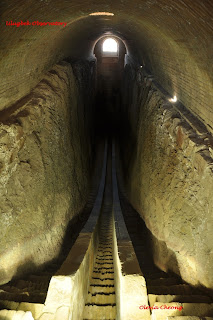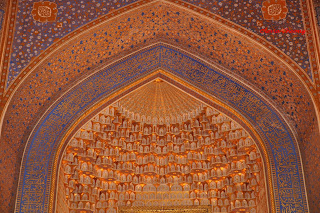Thank you for coming back.
This is the itinerary that I had done for my Central Asia Trip.
(Uzbekistan / Tajikistan / Kazakhstan / Kyrgyzstan)
Day 1 Depart Singapore for Tashkent via Kuala Lumpur (Uzbekistan Airways)
Day 2 Arrive Tashkent - 3 AM. Transfer to hotel. Rest. Lunch, and sightseeing.
Transfer to airport for flight to Bukhara.
Day 3 Start the sightseeing of Bukhara by foot.
Day 4 Depart Bukhara to Samarkand.
Visited Memorial Complex of Imam Al Bukhari
Short walk through the bazaar of Samarkand
Day 5 Full day sightseeing of Samarkand. Visited 5 main attractions.
Day 6 Depart for Shahrisabz (birth place of Amir Temur)
Continue drive to Termez
Day 7 Drive to Uzbek border. Start our journey in Tajikistan. Hissar Fortress. Continue to Dushanbe
Day 8 Dushanbe - Penjikent
Day 9 Penjikent - Hujand - Tashkent (Uzbekistan)
Day 10 Tashkent - more sightseeing. Board evening flight for Almaty (Kazakhstan)
Day 11 Almaty - walking tour
Drive to Bishkek (Kyrgyzstan). Sightseeing
Day 12 Bishkek - Isyl Kul Lake. Stay Cholpon Ata. Visit Museum.
Day 13 Cholpon Ata - Ala Archa National Park - Bishkek
Depart for Tashkent by flight.
Day 14 Tashkent
Day 15 Depart Tashkent for Singapore.
**
There is no flight from Tashkent into Tajikistan, so we travel overland and then back to Tashkent.
From Tashkent, we fly to Almaty and then travel to Kyrgyzstan.
I am happy to share with you my fond memories of my recent trip to Uzbekistan. And I was long ago captivated by the beauty and splendour of this ancient Silk Route city that I made up my mind to visit Uzbekistan. This is the important trade centre in the past, and during the rule of Tamerlane (Timur) , it flourished and prosper as many new buildings, mosques and minarets were erected during his reign. His grandson, Ulugbek continued his works of his grandfather, and bring more glory to this fascinating city.
Wish you visit Samarkand soon. And the International Music Festival is coming up in the last week of August - 25-30 August 2013, and it is being held right at the Registan Square, the heart of the city.
SAMARKAND
This is one of the most ancient cities of the world. It is situated deep in Central Asia, in an oasis of Zarafshan River. The city has more than 2,500 years old. And many people will probably think of Rome, in Italy. And many outstanding politicians and military commanders were connected with Samarkand: Alexander the Great, Ismail Samani, Sultan Sandjar, Genghis Khan, Amir Temur and Babur. Temur made Samarkand the capital of his empire. Architectural and archaeological masterpieces of Samarkand were entered in UNESCO's list of the World Heritage.
HISTORY OF SAMARKAND
The ancient part of Samarkand situated on Afrasiab hill was named after the legendary Turanian king. During the 8th century, the settlement occupied more than 200 hectares and was protected by river canals in the north and east and deep ravines in the south. In the time of the Achaemenids the city was encircled with a massive wall which had inside corridor and towers. Many scientists identify Afrasiab with the ancient Sogdian capital - Marakanda, which was destroyed by Alexander the Great in the 4th century BC.
Samarkand rose again in the 4th to the 8th century when the Great Silk Road became an important trade route. Samarkand became the strongest of Sogdian princedoms. In the 5th - 7th centuries, it was governed by the Hephthalites and Turks. In the 7th-8th centuries Samarkand recognised supremacy of Chinese Tang Dynasty. Four lines of new walls were built around Samarkand in that period. Zoroastrian, Buddhist and Christian Temples were built at that time. In the 8th century, Arabian troops headed by Quteiba conquered Samarkand.
In the 9th and 10th centuries Samarkand became a cultural centre of the Islamic East and the first capital of the Samanids. Ruins of the Samanids' palace with carved panels were found in the western sector of Afrasiab. In the 9th - 10th centuries, the inner city occupied 220 hectares. Its suburb with markets, mosques, bathhouses and caravansaries bordered with it in the south. The city was equipped with leaden water pipes. Manufacturing of Chinese paper was developing. Numerous workshops using water mills rose on the banks of the Siab.
In the 11th - 13th centuries, Samarkand became the capital of the western Qarakhanid state. It was newly walled. The Qarakhanids built their palace in the citadel. At the beginning of the 13th century Khoremshah Muhammad captured Samarkand and built a new palace. However, the state of Khorezmshahs was soon conquered by the Mongols. Genghis Khan took Samarkand after a short siege. The city suffered much due to Genghis Khan's internal wars in the second half of the 13th century. Afrasiab had been finally deserted.
In the 14th century, Samarkand rose in its southern suburb. Amir Temur (1336 - 1405), the governor of Western Chagatai Ulus, made it his capital. For a few decades, Amir Temur had formed a huge empire from India to the Mediterranean. Samarkand became a symbol of his new empire. Temur initiated huge construction works. New architecture with huge portals, high blue domes and refined majolica must have competed against Euroasian capitals and meant a birth of the Central Asian imperial style.
Amir Temur died before his Chinese campaign and was buried in Gur-Emir Mausoleum. The mausoleum was built for Temur's grandson Muhammad-sultan (1376-1403) who was expected to be his successor, but died too early. Remains of Seyid Berke, Amir Temur's spiritual teacher were also reburied there. The mausoleum was finished by Mirzo Ulugbek, another grandson of Temur. In the 15th century, one more remarkable cleric was buried in Gur-Emir. He was considered as Seyid Umar, son of Bukhara sheikh Amir Kulyal.
OUR SIGHTSEEING
It was a very beautiful day with clear blue sky. That is exactly what is required to have lovely pictures. We were traveling in the summer month of June, so it was still rather hot. Our first stop brought us to the Ulugbek Observatory. Ulugbek is the grandson of Amir Temur.
Statue of Ulugbek at the Ulugbek Observatory.
The biggest astronomical observatory in Samarkand was built in 1420s by Ulugbek. Here, during the three decades, scholars, including outstanding astronomers Qazi-Zadeh Rumi, Djemshid Giyas ad-Din Kashi and Ali Kushchi studied the skies. Samarkand observatory became famous owing to Ulugbek's book "Zidj", containing theoretical introduction and a catalogue of 1018 stars. The observatory was discovered by the Samarkand archaeologist Vyatkin V.L at the beginning of the 20th century. He excavated and found the underground remains of a huge quadrant - 40 metre in radius which was used for observation of the Sun, Moon and other bodies. See the photo above.
Then we visited the Bibi-Khanym Mosque, next to the main bazar. Such lovely turquoise blue-coloured dome!
This was constructed as the cathedral mosque of Samarkand, i.e. the main mosque f the Temurid Dynasty. Temur engaged the best architects, artists, and craftsmen from the conquered countries to build this mosque. Elephants were used for the lifting and transporting of the materials. It took five years for the construction. When Temur returned from his western campaign, he was disappointed with the construction, and ordered the portal to be reconstructed. After its completion, the portal was the highest of that time. Its arch was flanked with big pylons and minarets up to 50 meters high. This mosque is named after Temur's wife - Bibi Khanym.
We had sometime to wander through the bazar, and we were very impressed with the overall cleanliness of the bazar. I did not see rubbish thrown anyway around the whole bazar. Samarkand and Uzbekistan is very clean! We were totally impressed.
There were many kinds of dried fruits as you can find many different kinds of fruits in Uzbekistan - pomegranate, apricots, peaches, cherries, strawberries, melons, etc. However, it was a pity that we did not get to try pomegranate as the season is in the month of September.
Our next stop was the Shah-I-Zinda, which means the Tomb of the Living King. I really loved the bright blue domes, minarets and the mausoleums here. Wow.. it was so captivating! The beautiful tiles, and the decorations, as well as carvings on the walls were done by the highly skilled craftsman.
What a Masterpiece of creation!!!
The rise of Shah-i-Zinda necropolis on the slope of Afrasiab hill is connected with Kusam ibn Abbas, the Prophet's cousin. He took part in the Arab campaigns to Maverannahr, According to a legend, Kusam was mortally wounded at Samarkand walls and hid underground where he goes on living
. That gave the name of the necropolis - Shah-I-Zinda, which means the Tomb of the Living King. By the 10th-11th centuries, Kusam ibn Abbas had been considered as a martyr, Islamic saint and the patron of Samarkand. In the 12th-15th centuries, there was construction of a complex of numerous mausoleums and mosques along the path leading to Kusam's mausoleum. So, take a walk with me through the path of the Shah-I-Zinda.Another photo taken with a group of local students. They could speak quite good English.
ABOVE:
The picture in the plate - REGISTAN SQUARE.
Registan became the central square of Samarkand in the 14th century. The word "Registan" can be translated as "a sandy place". There was a canal which flowed through nearby and thus forming sand and slit deposits. Six streets crossed at Registan. In the time of Temur the square was used as a commercial and craft center and Ulugbeg made it a spiritual centre. Ulugbeg constructed a majestic madressa and Sufi khanaka with a huge dome. By the 17th century , old buildings of Registan had collapsed and the governor of Samarkand Yalangtushbiy built Sher-Dor madressa instead of Ulugbeg's khanaka and later Tillya-Kari Madressa.
The final attraction that we covered was Gur-Amir Mausoleum. (Pic - Below)
Temur Amir (1336 - 1405)
Temur was buried here in Gur-Amir Mausoleum, which he had built for his beloved grandson Muhammad-Sultan (1376-1403).
Hope you like the pictures that you see here. And I wish you could visit Samarkand and Uzbekistan one day. Be there to witness for yourself the grandeur of this city, which was one of the most ancient cities in the world, and also the many monuments, and construction works of Temur (the name which inspired immense fear throughout history) and his grandson, Ulugbeg.
Do come back and check out the pictures that I will post later for Tajikistan and Kyrgyzstan.
Olevia Cheong


































No comments:
Post a Comment